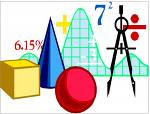Exponential notation :
A quantity with an exponent has three components--the base, the
exponent, and the coefficient.
In the quantity 3x^5, the coefficient is 3, the base is x, and the exponent is 5.
In the quantity 3(16)^7x, the coefficient is 3, the base is 16, and the exponent is 7x.
In the quantity 26(2y)^xy, the coefficient is 16, the base is 2y, and the exponent is xy.
In the quantity r^2, the (implied) coefficient is 1, the base is r, and the exponent is 2.
In the quantity 2y, the coefficient is 1, the base is y, and the (implied) exponent is 1.
**note x^9 is x raised to power 9 **
Negative Exponents
Taking a number to a negative exponent does not necessarily yield a negative answer.
The number raised to a negative exponent is a rational number.
a ^ -m = 1/a^m( the exponents becomes positive when it comes to denominator)
Example: find
(2) ^– 2 = 1 /2^2 =1/4
practice:find
7^-3
4^-2
6^-4
Answers:
1/343
1/16
1/1296
***If the base number is a fraction, then the negative exponent switches the numerator and the denominator***.
Example: find(2/3)^ -4
(3/2)^ 4
(3^ 4)/(2^ 4)
81/16
Example :find (- 5/6)^ -3
(6/(- 5)) ^3
(6 ^3)/((- 5) ^3)
216/(- 125)
- 216/125.
Practice : find
(7/5) ^-2
(-3/11)^ -1
(6/(-7)) ^-3
Answers:
25/49
-11/3
-343/216
Zero power or exponent
Any number raised to the zero power as 1
a^0 = 1
Example:
8^0 = 1
(- 17)^0 = 1
practice: find
(-6)^0
234^0
12^0
x^0
(1/8)^0
8.2365^0
Answers :
1
1
1
1
1
1
Laws of Exponents :
a^ 1 = a (If any variable or constant is written without an exponent , it is understood to have an exponent of 1)
a^ m * a ^n = a^( m + n) ( product Law for Exponents)
a ^m / a^ n = a ^(m – n) ( quotient Law for Exponents)
(a ^m) ^n = a ^ m n (power law for exponents)
Wednesday, August 20, 2008
Subscribe to:
Post Comments (Atom)

No comments:
Post a Comment